Welcome to the Learning Collaborative. This learning centre is intended to be a gathering place where users share the latest knowledge and evidence to catalyze innovation, sustain the HIV response and end AIDS for every child by 2020.
You can sort the documents in the resource center using the filters below. Filters can be used singly or in combination. You can reset the filters at anytime using the "Reset" button. The search function at the top of the page is also available. If you would like to submit a publication to the resource center, please send it to childrenandaids@unicef.org
| Document | Download | Web resource | Description | Year | |
|---|---|---|---|---|---|
| |
Commission on Narcotic Drugs Resolution 61-4.pdf | This high-level resolution promotes measures for preventing mother-to-child transmission of HIV, hepatitis B and C and syphilis among women who use drugs |
2018 | ||
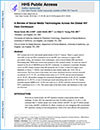
|
A review of social media technologies across the global HIV care continuum.pdf | Curr Opin Psychol: Garett et al, 2016 | Social media (SM) is immensely popular and is increasingly being used as a tool in HIV research. |
2016 | |
| |
CSE and me.pdf | A follow-up to "We Demand More!", this guide shares the experiences of CSE advocates working in restrictive or conservative environments, and provides further tips for advocacy. |
2017 | ||
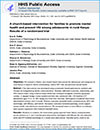
|
Church-based intervention for families to promote mental health and prevent HIV among adolescents.pdf | J Consult Clin Psychol: Puffer et al, 2016 | This intervention holds promise for strengthening positive family processes to protect against negative future outcomes for adolescents. |
2016 | |
| |
We demand more! A sexuality education advocacy handbook for young people.pdf | A handbook for young people who want to improve the sexuality education that is provided in their school, town or country. |
2017 | ||
| Cochrane Database: Lopez et al, 2016 | A review of school-based interventions to identify those that improved contraceptive use among adolescents. |
2016 | |||
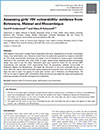
|
Assessing girls HIV vulnerability - Botswana, Malawi and Mozambique.pdf | Health Policy Plan: Underwood et al, 2016 | This study characterized, developed and tested a set of indicators to measure girls' vulnerability to HIV, resulting in the vulnerable girls index (VGI). |
2016 | |
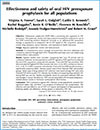
|
Effectiveness and safety of oral HIV preexposure prophylaxis for all populations.pdf | AIDS: Fonner et al, 2016 | PrEP is protective against HIV infection across populations, presents few significant safety risks, and there is no evidence of behavioral risk compensation. |
2016 | |
| AIDS Behav: Ballester-Arnal et al, 2016 | The purpose of this study was to develop and validate a risk index to assess the different sexual HIV risk exposure among Hispanic young people. |
2016 | |||

|
Sexual learning among East African adolescents in the context of generalized HIV epidemics.pdf | PLoS One: Knopf et al, 2017 | The three phases of sexual learning - 1) being primed for sex, 2) making sense of sex, and 3) having sexual experiences - interact to shape adolescents' sexual lives and their risk for HIV infectio |
2017 | |

|
Values and preferences on the use of PrEP among multiple populations.pdf | AIDS Behav: Koechlin et al, 2017 | Findings from a rapidly expanding evidence base suggest that the majority of populations most likely to benefit from PrEP feel positively towards it. |
2017 | |
| Sex in the shadow of HIV - Prevalence, risk factors, and interventions among HIV positive youth.pdf | PLoS One: Toska et al, 2017 | Sexual risk-taking among HIV-positive adolescents and youth is high, with inconclusive evidence on potential determinants. |
2017 | ||
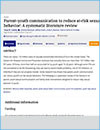
|
J Human Behavior Social Environment: Coakley et al, 2017 | Some research has shown that parent–youth communication can reduce youth’s at-risk sexual behaviors. |
2017 | ||
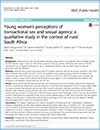
|
Young women's perceptions of transactional sex and sexual agency.pdf | BMC Public Health: Ranganathan et al, 2017 | Transactional sex is embedded in adolescent romantic relationships, but certain aspects make young women particularly vulnerable to HIV. |
2017 | |
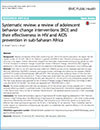
|
Adolescent behavior change interventions and their effectiveness in HIV prevention.pdf | BMC Public Health: Mwale et al, 2017 | There are mixed findings about the effectiveness of psychosocial BCI targeting adolescents in sub-Saharan Africa. Some studies portray intervention effectiveness and others limited efficacy. |
2017 | |
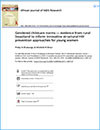
|
Gendered childcare norms.pdf | Afr J AIDS Res: Shabangu et al, 2017 | Innovative approaches to prevent HIV in young women should incorporate structural approaches that aim to transform gendered norms, economically empower women and implement policies guaranteeing wom |
2017 | |
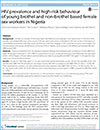
|
HIV prevalence and high-risk behaviour of young female sex workers in Nigeria.pdf | BMC Res Notes: Okafor et al, 2017 | Existing and future interventions on HIV prevention should focus on empowering young female sex workers with innovative and sustainable approaches aimed at improving their health and well-being. |
2017 | |
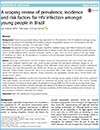
|
Prevalence, incidence and risk factors for HIV infection amongst young people in Brazil.pdf | BMC Infect Dis.: Saffier et al, 2017 | Few published studies have examined HIV amongst young people in Brazil, and those published have been largely cross-sectional and focused on traditional risk groups and the south of the country. |
2017 | |
| HIV risks and needs related to the SDGs among female sex workers commercially sexually exploited as children.pdf | JIAS: Grosso et al, 2018 | Risk determinants for HIV and violence among sexually exploited children can be studied retrospectively through research with adult female sex workers. |
2018 | ||
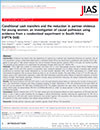
|
Conditional cash transfers and the reduction in partner violence for young women.pdf | JIAS: Kilburn et al, 2018 | A conditional cash transfer for high school girls has protective effects on their experience of intimate partner violence (IPV), and the effect is due in part to girls choosing not to engage in sex |
2018 |